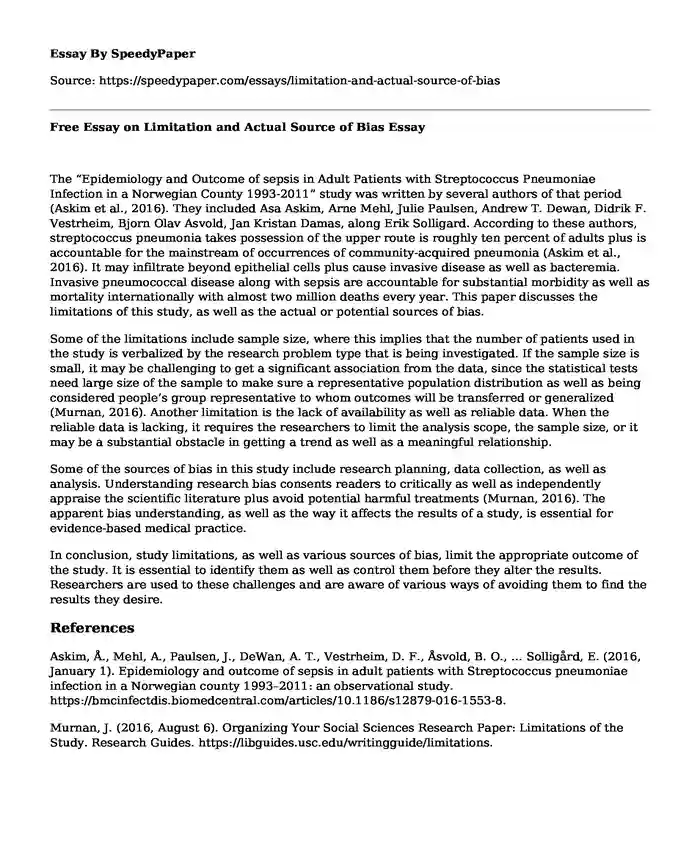
| Essay type: | Rhetorical analysis essays |
| Categories: | Knowledge Medicine Disorder |
| Pages: | 2 |
| Wordcount: | 462 words |
The “Epidemiology and Outcome of sepsis in Adult Patients with Streptococcus Pneumoniae Infection in a Norwegian County 1993-2011” study was written by several authors of that period (Askim et al., 2016). They included Asa Askim, Arne Mehl, Julie Paulsen, Andrew T. Dewan, Didrik F. Vestrheim, Bjorn Olav Asvold, Jan Kristan Damas, along Erik Solligard. According to these authors, streptococcus pneumonia takes possession of the upper route is roughly ten percent of adults plus is accountable for the mainstream of occurrences of community-acquired pneumonia (Askim et al., 2016). It may infiltrate beyond epithelial cells plus cause invasive disease as well as bacteremia. Invasive pneumococcal disease along with sepsis are accountable for substantial morbidity as well as mortality internationally with almost two million deaths every year. This paper discusses the limitations of this study, as well as the actual or potential sources of bias.
Some of the limitations include sample size, where this implies that the number of patients used in the study is verbalized by the research problem type that is being investigated. If the sample size is small, it may be challenging to get a significant association from the data, since the statistical tests need large size of the sample to make sure a representative population distribution as well as being considered people’s group representative to whom outcomes will be transferred or generalized (Murnan, 2016). Another limitation is the lack of availability as well as reliable data. When the reliable data is lacking, it requires the researchers to limit the analysis scope, the sample size, or it may be a substantial obstacle in getting a trend as well as a meaningful relationship.
Some of the sources of bias in this study include research planning, data collection, as well as analysis. Understanding research bias consents readers to critically as well as independently appraise the scientific literature plus avoid potential harmful treatments (Murnan, 2016). The apparent bias understanding, as well as the way it affects the results of a study, is essential for evidence-based medical practice.
In conclusion, study limitations, as well as various sources of bias, limit the appropriate outcome of the study. It is essential to identify them as well as control them before they alter the results. Researchers are used to these challenges and are aware of various ways of avoiding them to find the results they desire.
References
Askim, Å., Mehl, A., Paulsen, J., DeWan, A. T., Vestrheim, D. F., Åsvold, B. O., … Solligård, E. (2016, January 1). Epidemiology and outcome of sepsis in adult patients with Streptococcus pneumoniae infection in a Norwegian county 1993–2011: an observational study. https://bmcinfectdis.biomedcentral.com/articles/10.1186/s12879-016-1553-8.
Murnan, J. (2016, August 6). Organizing Your Social Sciences Research Paper: Limitations of the Study. Research Guides. https://libguides.usc.edu/writingguide/limitations.
Cite this page
Free Essay on Limitation and Actual Source of Bias. (2023, Dec 03). Retrieved from https://speedypaper.com/essays/limitation-and-actual-source-of-bias
Request Removal
If you are the original author of this essay and no longer wish to have it published on the SpeedyPaper website, please click below to request its removal:
- Free Case Study Example on Child Development Theories
- Annotated Bibliography on Disability Services, Free Example
- Other Limitations of the MAP-IT Model as It Relates to My Colleague's Theory. Free Essay
- Essay Sample on Spanish Flu Pandemic in America
- Essay Sample on Curriculum Action Plan for Kindergarten
- Role of a Nurse in Suicide Prevention and Mental Health Promotion - Essay Sample
- Essay Sample on Medication Errors
Popular categories




